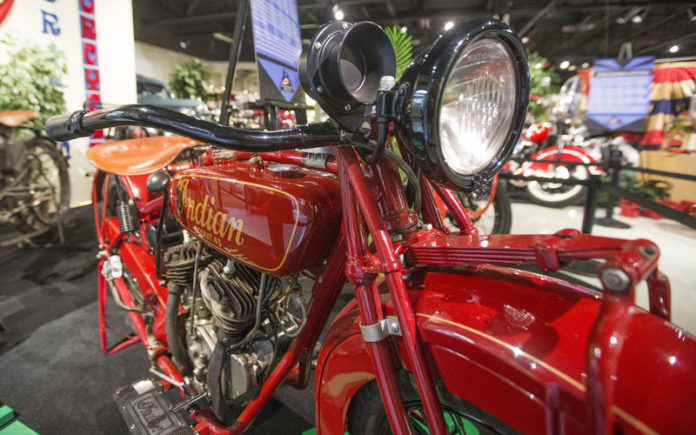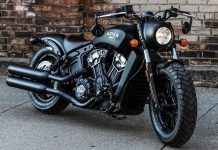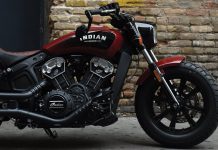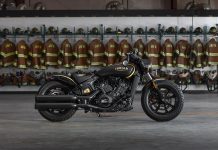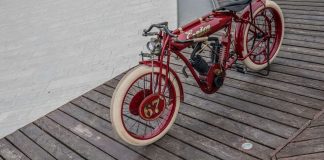If your Visiting South Bend Indiana anytime soon, here’s a museum that will be showcasing Indian Motorcycles for the next few months!
Get your motor runnin’ for a wind-in-your-hair parallel ride alongside this country’s history of the automobile
There was only one way to top that first Harley-Davidson exhibit.
The Studebaker National Museum put Harley-Davidson alongside a vintage collection of all the American-made motorcycles — Harley-Davidson, Indian, Yale, Excelsior and Victory — on exhibit for the next six months for a wind-in-your-hair parallel ride alongside this country’s history of the automobile.
“We wanted to come up with (an) American-made motorcycle collection, so we came up with these,” Studebaker Museum facilities manager Don Filley says about the exhibit he designed.
“These” hit your eyes right at the doorway in the form of a gray 1910 Yale Single, which looks more like a sleek-old-style bicycle on oversized wheels with a postbox-shaped carrier case and a saddle leather seat.
The 1910 Yale Single sits with two other Yale models and a 1916 Reading Standard, an old, two-wheeled bicycle-design model powered by a V Twin side valve 72-cubic-inch engine that is showing its age with some rust on the wheels. Reading Standard was among the pioneers of motorcycle manufacturing, beginning operations in 1903.
Then there’s the 1927 Indian Scout 45, which made its debut on the road in 1920 with a 37-cubic-inch engine, and introduces the Indian motorcycle manufacturer to the exhibit alongside its brother model, a sparkling, beige and turquoise two-toned 1941 Indian Chief and its bullet-shaped sidecar.
“We really wanted to kind of look back at the early history,” Studebaker Museum archivist Andy Beckman says. “At first, they looked like bicycles, but you see the evolution of body style here.”
The atmosphere of a vintage collection hovers over the relationship between Harley-Davidson and Indian during the early years. The motorcycle icons faced head-to-head battles throughout the 1930s and ’40s, with both companies offering a wide product line.
Indian put out motorcycles with both twin and four-cylinder models, while Harley-Davidson featured smaller, single-cylinder bikes along with its twin-engine models. The color spectrum also expanded during this era, and both companies matched each other with mechanical modernizations that improved reliability and comfort, such as the Indian Chief line featuring a plunger rear suspension system that greatly improved ride quality.
And both companies transitioned to military production to make rides for soldiers during World War II — American and foreign. Harley-Davidson produced nearly 90,000 bikes for the U.S. Army, while Indian built more than 40,000 bikes, with most being shipped to the Russian army.
But while Harley-Davidson grew during the post-war years by opening new plants and introducing new models, Indian experienced a bad run of quality issues and sales plummeted. Indian ceased production of its traditional models in 1953 and continued selling its line of Bath motorcycles through the 1960s.
“It’s just interesting to see how the technologies advanced,” Beckman says. “Harley was getting the overhead valve knucklehead engine, and Indian was perfectly happy with the flathead. But Indians were much easier to ride with the softer tail, the rear suspension, where Harley kept the hard tail until the ’50s.”
Each U.S. motorcycle manufacturer in history is represented — Harley-Davidson, Indian, Excelsior, Victory and Yale — in vintage bikes all loaned to the Studebaker exhibit by local collectors.
“Just collectors around the area,” Filley says.
One of those, says Beckman, was talking about how he defied age and still took his vintage collection bikes out for a spin when Studebaker hosted the Harley exhibit in 2009 that drew “a great turnout” and prompted the current expanded sequel — which runs through May 10.
“The gentleman who loaned some of the early bikes, he still rides,” Beckman says of Bruce Lindsay. “The last time we did the Harley show, somebody approached him and asked if he still rode any of the old bikes, and he said, ‘Oh yeah, I still go out and ride my 1900s-era bikes.’
“Wow,” Beckman says, “that’s dedication.”
Source: Vintage motorcycles on exhibit at Studebaker National Museum – South Bend Tribune: Event News

